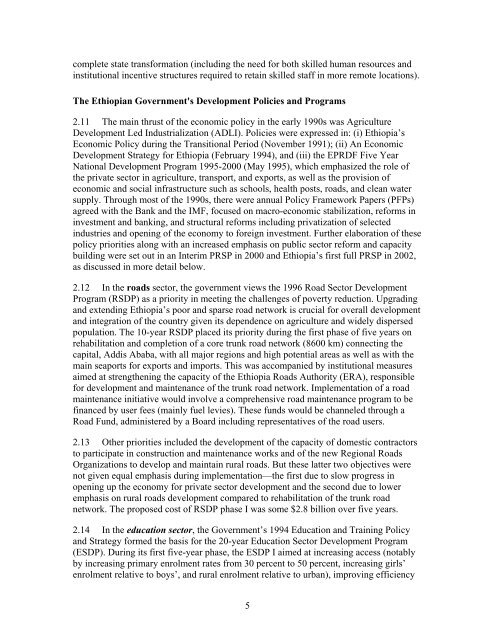An Independent Review of World Bank Support to ... - DAG Ethiopia
An Independent Review of World Bank Support to ... - DAG Ethiopia
An Independent Review of World Bank Support to ... - DAG Ethiopia
You also want an ePaper? Increase the reach of your titles
YUMPU automatically turns print PDFs into web optimized ePapers that Google loves.
complete state transformation (including the need for both skilled human resources andinstitutional incentive structures required <strong>to</strong> retain skilled staff in more remote locations).The <strong>Ethiopia</strong>n Government's Development Policies and Programs2.11 The main thrust <strong>of</strong> the economic policy in the early 1990s was AgricultureDevelopment Led Industrialization (ADLI). Policies were expressed in: (i) <strong>Ethiopia</strong>’sEconomic Policy during the Transitional Period (November 1991); (ii) <strong>An</strong> EconomicDevelopment Strategy for <strong>Ethiopia</strong> (February 1994), and (iii) the EPRDF Five YearNational Development Program 1995-2000 (May 1995), which emphasized the role <strong>of</strong>the private sec<strong>to</strong>r in agriculture, transport, and exports, as well as the provision <strong>of</strong>economic and social infrastructure such as schools, health posts, roads, and clean watersupply. Through most <strong>of</strong> the 1990s, there were annual Policy Framework Papers (PFPs)agreed with the <strong>Bank</strong> and the IMF, focused on macro-economic stabilization, reforms ininvestment and banking, and structural reforms including privatization <strong>of</strong> selectedindustries and opening <strong>of</strong> the economy <strong>to</strong> foreign investment. Further elaboration <strong>of</strong> thesepolicy priorities along with an increased emphasis on public sec<strong>to</strong>r reform and capacitybuilding were set out in an Interim PRSP in 2000 and <strong>Ethiopia</strong>’s first full PRSP in 2002,as discussed in more detail below.2.12 In the roads sec<strong>to</strong>r, the government views the 1996 Road Sec<strong>to</strong>r DevelopmentProgram (RSDP) as a priority in meeting the challenges <strong>of</strong> poverty reduction. Upgradingand extending <strong>Ethiopia</strong>’s poor and sparse road network is crucial for overall developmentand integration <strong>of</strong> the country given its dependence on agriculture and widely dispersedpopulation. The 10-year RSDP placed its priority during the first phase <strong>of</strong> five years onrehabilitation and completion <strong>of</strong> a core trunk road network (8600 km) connecting thecapital, Addis Ababa, with all major regions and high potential areas as well as with themain seaports for exports and imports. This was accompanied by institutional measuresaimed at strengthening the capacity <strong>of</strong> the <strong>Ethiopia</strong> Roads Authority (ERA), responsiblefor development and maintenance <strong>of</strong> the trunk road network. Implementation <strong>of</strong> a roadmaintenance initiative would involve a comprehensive road maintenance program <strong>to</strong> befinanced by user fees (mainly fuel levies). These funds would be channeled through aRoad Fund, administered by a Board including representatives <strong>of</strong> the road users.2.13 Other priorities included the development <strong>of</strong> the capacity <strong>of</strong> domestic contrac<strong>to</strong>rs<strong>to</strong> participate in construction and maintenance works and <strong>of</strong> the new Regional RoadsOrganizations <strong>to</strong> develop and maintain rural roads. But these latter two objectives werenot given equal emphasis during implementation—the first due <strong>to</strong> slow progress inopening up the economy for private sec<strong>to</strong>r development and the second due <strong>to</strong> loweremphasis on rural roads development compared <strong>to</strong> rehabilitation <strong>of</strong> the trunk roadnetwork. The proposed cost <strong>of</strong> RSDP phase I was some $2.8 billion over five years.2.14 In the education sec<strong>to</strong>r, the Government’s 1994 Education and Training Policyand Strategy formed the basis for the 20-year Education Sec<strong>to</strong>r Development Program(ESDP). During its first five-year phase, the ESDP I aimed at increasing access (notablyby increasing primary enrolment rates from 30 percent <strong>to</strong> 50 percent, increasing girls’enrolment relative <strong>to</strong> boys’, and rural enrolment relative <strong>to</strong> urban), improving efficiency5
















